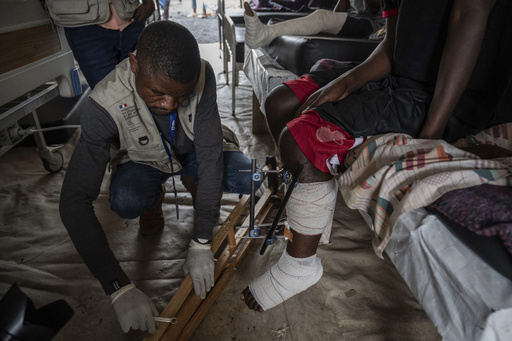
GOMA, Congo — A significant influx of injured individuals has overwhelmed hospitals in Goma, a key city in eastern Congo, as clashes continue between government troops and Rwanda-backed insurgents who have taken control of the city, home to approximately 2 million residents.
“The risk of infection increases daily as we struggle to treat them all,” stated Florence Douet, an operating room nurse at Bethesda Hospital, as she provided care to patients with a variety of injuries.
Since the M23 insurgents initiated their offensive in Goma on January 26, local officials report that over 700 people have lost their lives and nearly 3,000 have sustained injuries either in the city or its surrounding areas. Bethesda Hospital itself is now admitting more than 100 new patients each day, pushing its 250-bed capacity to the limit.
Bethesda is among several hospitals in Goma that are facing serious logistical challenges. The city accommodates a large portion of the nearly 6.5 million people displaced due to ongoing conflict, marking this situation as one of the world’s largest humanitarian disasters.
As more individuals arrive at medical facilities with gunshot or shrapnel wounds, many have been compelled to share beds or lie on the floor, desperately awaiting medical care.
“I’ve never witnessed anything like this before,” remarked Patrick Bagamuhunda, a patient injured amid the fighting. “This conflict has inflicted severe damage, but at least we are still alive.”
The M23 rebels, reinforced by around 4,000 troops from neighboring Rwanda, have emerged as the most formidable faction among more than 100 armed groups contesting control in Congo’s mineral-rich eastern region. Unlike their previous campaign in 2012, during which they captured Goma and later retreated under international pressure, the rebels are now boldly stating their intention to advance to Kinshasa, Congo’s capital, located 1,000 miles away. They criticize President Félix Tshisekedi’s government as ineffective and view the nation as a failed state.
The conflict has roots in a long-standing ethnic struggle, with the M23 claiming to protect the rights of ethnic Tutsis within Congo. Rwanda alleges that Tutsis are facing persecution from Hutus and remnants of militias tied to the genocide that claimed 800,000 Tutsis and others in 1994. Following the genocide, many Hutus sought refuge in Congo, giving rise to the Democratic Forces for the Liberation of Rwanda (FDLR) militia. Rwanda asserts that the FDLR is deeply embedded in the Congolese military, a claim that the military denies.
At Kyeshero Hospital in Goma, medical professionals are reporting a surge in patients suffering from bullet wounds. “We extracted 48 bullets just yesterday,” noted surgeon Johnny Kasangati while attending to a patient in a makeshift tent.
Kyeshero Hospital is similarly grappling with overcrowding, reportedly operating at over 200% capacity on certain days, according to project coordinator Joseph Amadomon Sagara from Doctors Without Borders.
Historically, hospitals in Goma could transport critically injured patients by boat to the main city of Bukavu, located 180 kilometers to the south. However, transportation across Lake Kivu has been halted due to the uprising, and road access is largely blocked.
The ongoing conflict in and around Goma has also disrupted vital supply lines, resulting in medical shortages that aid organizations rely on. Previously, supplies arrived through Goma’s international airport, which is currently under the control of insurgents.

